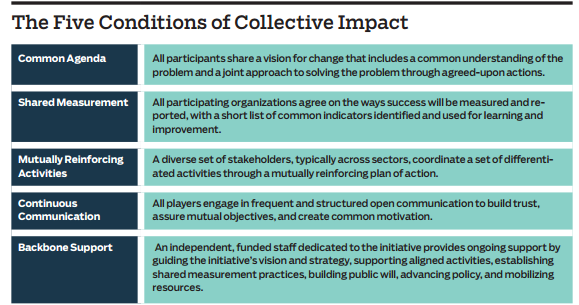
I have occasionally referred to the Collective Impact Model, a powerful approach cross-sector collaboration used by many communities across the country, including Pittsfield. The approach is based on the five conditions shown in the graphic above. The Collective Impact Forum has recently shared a great collection of resources in its Top Reads and Resources for 2014. In particular I recommend Committing to Collective Impact: From Vision to Implementation and Collective Insights on Collective Impact, the second and third items on the list. Also, see the video about Somerville’s Collective Impact initiative, Shape Up Somerville, under Top Videos.
The following passages from “Essential Mindset Shifts for Collective Impact” (in the Collective Insights document) reinforce the connections between relationships, capacity, and innovation that I described in October. Note the joint emphasis on evidence and relationships and on “collective seeing, learning, and doing.”
We have seen that data and evidence are critical inputs for collective impact efforts, but we must not underestimate the power of relationships. Lack of personal relationships, as well as the presence of strong egos and difficult historical interactions, can impede collective impact efforts. Collective impact practitioners must invest time in building strong interpersonal relationships and trust, which enable collective visioning and learning. …Collective impact can succeed only when the process attends to both the use of evidence and the strengthening of relationships. …
We believe that a critical mindset shift is needed: Collective impact practitioners must recognize that the power of collective impact comes from enabling “collective seeing, learning, and doing,” rather than following a linear plan. The structures that collective impact efforts create enable people to come together regularly to look at data and learn from one another, to understand what is working and what is not. Such interaction leads partners to adjust their actions, “doubling down” on effective strategies and allowing new solutions to emerge.